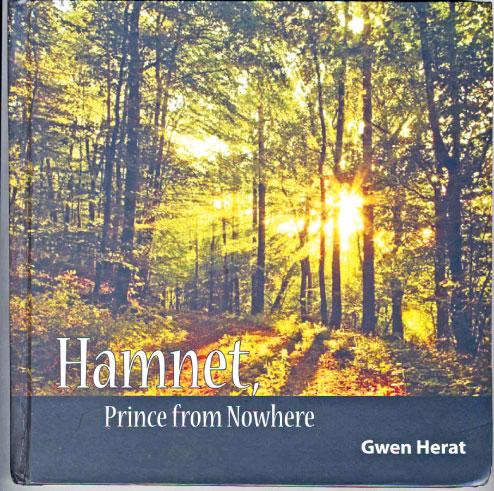
Most readers are quite familiar with William Shakespeare’s Hamlet which has been performed more than any other play in the world. At the same time, there has been more criticism written about Hamlet than any other work of literature. What is more, there are nearly 50 movie versions of Hamlet, more than 25 ballets, six operas, and dozens of assorted musical compositions. According to authoritative literary sources, Hamlet’s lament, “To be or not to be” is the most quoted phrase in English. Hamlet is also the longest of Shakespeare’s plays.
Shakespeare scholar Gwen Herat’s Hamnet Prince of Nowhere imaginatively predates Shakespeare’s Hamlet. She creates a world of intrigue and lost romance through a narrative written in prose and verse. The author, however, has borrowed certain characters such as, Hamlet and Ophelia from the original play.
The narrative starts with a scene where two spirits roam the countryside. One was the spirit of Ophelia who was attacked by a sloth bear. After yearning for Hamnet’s love, she was left bereaved. Suddenly, she remembers how Hamnet was mortally wounded by the sloth bear. She begins to hear screams echoing across the woods disturbing the silence of the night. Meanwhile, Hamlet begins to hear Ophelia’s gentle moaning from her tomb.
One day, Hamlet was placing some flowers at the tomb when he heard Ophelia’s calling for help. He heard his deceased sister’s voice distinctly and slumps to the ground. Laertes revives him and tries to proceed towards the tomb. Gertrude sees the duo disappearing into the darkness from a window of the palace. She informs the king about the incident. Then Hamlet force opens the tomb. They see Ophelia still alive in the tomb, and they carry her to a chamber.
Later, Ophelia sits up and thinks about what happened to Hamnet. Thereafter, she hurries to Hamnet’s tomb only to find it sealed. At last, she feels his presence in the yonder clouds.
The incredible saga takes place on the outer ramparts of Elsimore castle. Shakespeare’s source of Hamlet is known as the ‘Ur: Hamlet’, a play now lost that was popular in the late 1500s. It comes from a ninth century saga about Amleth, a pre-Viking prince, who assumed a mask of madness to protect himself from his uncle, who had killed his father. After avenging his father’s death, Amleth went on to other heroic deeds.
With such historical facts in the background, Gwen Herat has begun to narrate her story after Hamlet’s death. Hamlet and Hamnet are twins but they are quite different in character. Hamlet is brave and ambitious, but Hamnet remains a mysterious prince.
The section titled “Incarnation” is written in verse. It is the lamentation of Ophelia over the death of Hamnet. She asks:
“Thou will not leave me in the dust
And in ashes or make me slight, would thou?”
In another place, Ophelia addresses Hamnet in the following verse:
“Hamnet, thou art the dark-eyed prince fair in face
And every maiden’s dream
If thou will their dreams come true,
Many a sun will cross the shore.”
Taken as a whole, Gwen Herat has captured the essence of Ophelia’s eternal love for Hamnet. In fact, Hamnet, Prince from Nowhere will elevate the author as a brilliant creative writer in the halls of fame.
